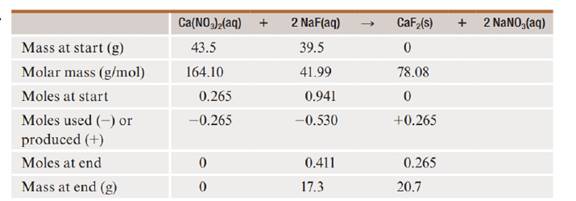
Concept explainers
A solution containing
Interpretation:
The precipitated mass of calcium fluoride is to be calculated. The reactant which will be in excess is to be stated. The mass of the reactant that will be in excess is to be stated.
Concept introduction:
Chemical reactions are represented by chemical equations. In a chemical equation the reactants are represented on the left of the arrow while the products are represented on the right of the arrow. Stoichiometric coefficient is the number preceding each symbol in a reaction which determines the moles of the reactants and products in the reaction. The ratio of moles is termed as mole ratio. In stoichiometry problems, the reactant that controls the amount of the product formed is known as the limiting reactant.
Answer to Problem 10PE
The precipitated mass of calcium fluoride is
Explanation of Solution

The balanced equation for the reaction is given below.
In the reaction,
Therefore mole to mole ratio is given below.
Therefore, two conversion factors from the mole-to-mole ratio are given below.
The conversion factor to obtain moles of
The molar mass of sodium is
The molar mass of fluorine is
Therefore, the molar mass of
The formula to calculate the number of moles of
The mass of
Subsitute the mass and molar mass of
The molar mass of calcium is
The molar mass of oxygen is
The molar mass of nitrogen is
Therefore, the molar mass of
The formula to calculate the number of moles of
The mass of
Subsitute the mass and molar mass of
The number of moles of
The number of moles of
Therefore, the number of moles of
The moles of
The formula to calculate the mass of
Substitute molar mass and the mass of
Therefore, the mass of
In the reaction,
Therefore mole to mole ratio is given below.
Therefore, two conversion factors from the mole-to-mole ratio are given below.
The conversion factor to obtain moles of
Therefore, the number of moles of
The molar mass of calcium is
The molar mass of fluorine is
Therefore, the molar mass of
The formula to calculate the mass of
The number of moles of
Subsitute the moles and molar mass of
Therefore the mass of
After the reaction, the mass of
Therefore, the precipitated mass of calcium fluoride is
The precipitated mass of calcium fluoride is
Want to see more full solutions like this?
Chapter 10 Solutions
EBK INTRODUCTORY CHEMISTRY: AN ACTIVE L
- A mixture of C7H12O2, C9H9OCl, biphenyl and acetone was put together in a gas chromatography tube. Please decide from the GC resutls which correspond to the peak for C7,C9 and biphenyl and explain the reasoning based on GC results. Eliminate unnecessary peaks from Gas Chromatography results.arrow_forwardIs the molecule chiral, meso, or achiral? CI .CH3 H₂C CIarrow_forwardPLEASE HELP ! URGENT!arrow_forward
- Identify priority of the substituents: CH3arrow_forwardHow many chiral carbons are in the molecule? OH F CI Brarrow_forwardA mixture of three compounds Phen-A, Acet-B and Rin-C was analyzed using TLC with 1:9 ethanol: hexane as the mobile phase. The TLC plate showed three spots of R, 0.1 and 0.2 and 0.3. Which of the three compounds (Phen-A; Acet-B or Rin-C) would have the highest (Blank 1), middle (Blank 2) and lowest (Blank 3) spot respectively? 0 CH: 0 CH, 0 H.C OH H.CN OH Acet-B Rin-C phen-A A A <arrow_forward
 Principles of Modern ChemistryChemistryISBN:9781305079113Author:David W. Oxtoby, H. Pat Gillis, Laurie J. ButlerPublisher:Cengage Learning
Principles of Modern ChemistryChemistryISBN:9781305079113Author:David W. Oxtoby, H. Pat Gillis, Laurie J. ButlerPublisher:Cengage Learning Introductory Chemistry: An Active Learning Approa...ChemistryISBN:9781305079250Author:Mark S. Cracolice, Ed PetersPublisher:Cengage Learning
Introductory Chemistry: An Active Learning Approa...ChemistryISBN:9781305079250Author:Mark S. Cracolice, Ed PetersPublisher:Cengage Learning Introductory Chemistry: A FoundationChemistryISBN:9781337399425Author:Steven S. Zumdahl, Donald J. DeCostePublisher:Cengage Learning
Introductory Chemistry: A FoundationChemistryISBN:9781337399425Author:Steven S. Zumdahl, Donald J. DeCostePublisher:Cengage Learning Chemistry: An Atoms First ApproachChemistryISBN:9781305079243Author:Steven S. Zumdahl, Susan A. ZumdahlPublisher:Cengage LearningChemistry: Matter and ChangeChemistryISBN:9780078746376Author:Dinah Zike, Laurel Dingrando, Nicholas Hainen, Cheryl WistromPublisher:Glencoe/McGraw-Hill School Pub Co
Chemistry: An Atoms First ApproachChemistryISBN:9781305079243Author:Steven S. Zumdahl, Susan A. ZumdahlPublisher:Cengage LearningChemistry: Matter and ChangeChemistryISBN:9780078746376Author:Dinah Zike, Laurel Dingrando, Nicholas Hainen, Cheryl WistromPublisher:Glencoe/McGraw-Hill School Pub Co ChemistryChemistryISBN:9781305957404Author:Steven S. Zumdahl, Susan A. Zumdahl, Donald J. DeCostePublisher:Cengage Learning
ChemistryChemistryISBN:9781305957404Author:Steven S. Zumdahl, Susan A. Zumdahl, Donald J. DeCostePublisher:Cengage Learning





